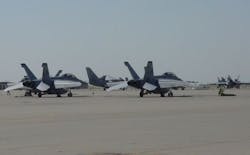Intrusion at Navy jet station points to terrorism vulnerabilities at U.S. military bases
A high-speed police car chase early last Thursday resulted in the penetration of two security checkpoints, serious damage to a $61 million F/A-18E Super Hornet jet fighter-bomber, and the deaths of two people at Lemoore Naval Air Station in Central California.
Lemoore NAS is home to the Pacific Fleet's strike fighter wing, and will be the future base for Pacific Fleet F-35C Lightning II joint strike fighter aircraft. With the expected transfer of two Super Hornet squadrons to Lemoore later this year, 60 percent of the Navy's carrier-based strike fighter capability will be based there.
The two occupants of the vehicle that led law enforcement on a high-speed chase suffered fatal injuries when their Jeep Grand Cherokee crashed into the tail of a Super Hornet parked on the Lemoore flight line. Suffice it to say that this incident, which ended up to be a local law-enforcement matter, could have been worse ... a whole lot worse.
What if that vehicle wasn't just running from police, but instead had been packed with terrorist explosives, or even a small nuclear device? How many advanced sophisticated Navy aircraft would have been destroyed or damaged? How many naval personnel would have been killed or injured? What kind of a setback would that have dealt to important Navy aviation support facilities?
Fortunately we can't know that ... yet.
story continues below
This incident hit me in a personal way when I read about it late last week. I covered that base more than 30 years ago for The Hanford Sentinel daily newspaper, and I've been on that base more times than I can count.
Since I know Lemoore NAS, it's astounding to me that a car running from police could have made it as far as the base's flight line and aircraft squadrons.
The operations area at Lemoore, where the base's runways, hangars, aircraft, and aviation support facilities are, is about five miles from the base's main gate. To get there you have to go through not one, but two security checkpoints, presumably with trained and armed Navy security personnel on duty.
At least one of those two security checkpoints has hydraulic barriers that can be raised up from the ground to prevent vehicles from entering, according to a story by The Hanford Sentinel's Seth Nidever headlined How did Jeep driver manage to crash into fighter jet?
story continues below
It's a puzzle to me how a car fleeing police could have blown through one security checkpoint at the base's main gate, and then through a second security checkpoint five miles away. To put a point on it, no intruder should be able to get past Navy security guarding some of the nation's most powerful and sophisticated weapon systems. No one.
One of Nidever's follow-up stories says hydraulic barriers were raised after the fleeing car passed through a crucial checkpoint. A Navy spokesman said the barriers "were raised after the pursuit had passed through to prevent the suspect vehicle from escaping."
Nice try.
Related: Parallel courses and the value of renewing old friendships
This was nothing less than a grotesque breach of security at one of the nation's most important and sensitive military installations. It would have taken that fleeing vehicle at least several minutes, even at high speed, to make it from where the vehicle broke into the base to the operations area where the aircraft are parked.
That's more than enough time for security personnel to prevent such a thing from happening. Nevertheless, it did happen, and Navy leaders have to answer for it.
There's little doubt that this incident will cause a top-to-bottom security assessment at Lemoore NAS; big improvements will be made. Such security improvements will be a welcome first step, but I can't help wondering that if something like this can happen at Lemoore, what kinds of terrorist attacks might be just waiting to happen at other sensitive and important military bases?
This should be a lesson and a wakeup call to every U.S. military base, here or overseas, about the importance of keeping facilities secure from intruders of all types.
